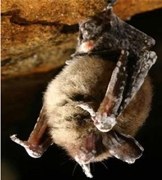White-nose Syndrome – a new threat to bat populations
Bat Conservation Ireland have contacted us regarding White Nose Syndrome, a cave dwelling fungus that has wiped out large populations of bats in Eastern America that recently been confirmed in France.

Bat with White Nose Syndrome
There is widespread concern for bats in United States due to the deaths of over 1,000,000 bats in hibernation sites since 2006. White-nose Syndrome (WNS) is now known to be responsible for the deaths. A psychrophilic (cold-loving) fungus, Geomyces destructans, has been identified to be associated with WNS. To-date, this fungus was restricted to the north-eastern United States, however, a bat (Myotis myotis) found in a cave in France on the 12th March 2009 was confirmed to have the fungus. In addition, bats in Germany and The Netherlands have also been observed with fungal growths, but to-date WNS has not been confirmed.
The disease is associated with hibernating, cave-roosting insectivorous bats. Infected bats have conspicuous white powdery deposits on their muzzle (hence the name White-nose Syndrome), ears and wings. Further analysis has shown that the fungus actually penetrates deep into the membranes and tissues of the bats and cause swellings on the wings. Bats that exhibit the syndrome have little or no fat reserves reducing the likelihood of surviving the winter. WNS was first observed in a cave in Albany, New York during the winter of 2006. Since then, populations of cave-hibernating bats have been drastically declining in a total of seven states. Affected species includes little brown bats, northern bats, tricolored bats, Indiana bats, small-footed myotis and big brown bats. Mortality rates as high as 100 percent have been observed in hibernacula affected by WNS in the United States.
A team of researchers in UCD in collaboration with their French colleagues confirmed the presence of this fungus in a bat in France and review the possible implications for bat conservation in Puechmaille et al (2010). They emphasise “the need to understand, monitor and control the progression of WNS” since bats constitute more than 25% of the world’s mammalian populations and play major roles in insect control and ecosystem functions.
Scientists are reasonably certain that WNS is transmitted from bat-to-bat. However the fungus may also be transported by people from cave to cave and, as a result, caving activity in WNS-affected states and adjacent states in the US has been curtailed. In addition, cave users are asked to avoid entering caves and other underground sites during hibernation and also to disinfect clothing and gear between site visits. While WNS has not been found in Irish caves, many of our bat species are known to hibernate in caves. Therefore it is important that cave users are aware of WNS and take precautionary action.
Bat Conservation Ireland is currently compiling a fact sheet on WNS and this will be distributed widely. If you wish to receive further information, please email info [at] batconservationireland [dot] org.